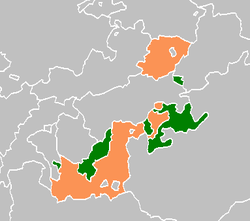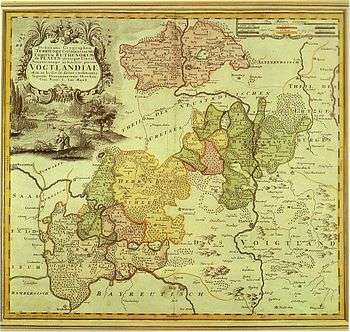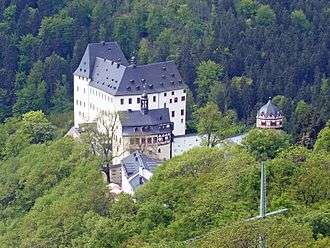Imperial County of Reuss
Reuss (German: Reuß) was the name of several historical states located in present-day Thuringia, Germany. Its rulers, the House of Reuss, named all of their male children Heinrich (English: Henry) after the end of the 12th century in honour of Henry VI, Holy Roman Emperor (1190–1197), to whom they owed the estates of Weida and Gera. The head of each branch of the family bore the German title Fürst (Prince) as did their male children.
Imperial County of Reuss Reichsgrafschaft Reuß | |||||||||||
|---|---|---|---|---|---|---|---|---|---|---|---|
| c. 1010–1778/1806 | |||||||||||
 Coat of arms
| |||||||||||
 Reuss in 1820: Elder (green) and Younger (orange) line | |||||||||||
| Status | County | ||||||||||
| Capital | Weida until 1531, then Plauen, Gera and Greiz | ||||||||||
| Government | Principality | ||||||||||
| Historical era | Middle Ages | ||||||||||
• Established | c. 1010 | ||||||||||
| c. 1206 | |||||||||||
• Partitioned into Elder, Middle and Younger line | 1564 | ||||||||||
• Principality of Reuss Elder Line | 1778 | ||||||||||
• Principality of Reuss Junior Line | 1806 | ||||||||||
| |||||||||||
History of the various states
Several different principalities of the House of Reuss which had previously existed had by the time of the formation of the German Confederation become part of the two remaining lines (the Elder and the Younger lines). Before then, they had been part first of the Holy Roman Empire, and then the Confederation of the Rhine.
Origins
The region including what would become the Principality of Reuss was inhabited in early medieval times by Slavic people who were converted to Christianity by the German Emperor Otto I (936–973). In church matters the region was under the Diocese of Zeitz (founded in 968), which became a suffragan of Magdeburg. On account of the frequent inroads of the Slavs, the residence of the Bishop of Zeitz was removed to Naumburg in 1028, after which the See was called Naumburg-Zeitz.[1]
Upon its subjection to German authority, the whole province was allotted to the March of Zeitz. As early as the year 1000, however, Emperor Otto III permitted the entire part lying on the eastern boundary of Thuringia to be administered by imperial vogts, or bailiffs (advocati imperii), whence this territory received the name of Vogtland (Terra advocatorum), a designation that has remained to this day a geographical summary for Reuss, especially that part on the Saxon borders. The position of vogt soon became hereditary. The princes of Reuss are descended from the vogts of Weida.[1]
Early House of Reuss
Erkenbert I (1122) is proved by documentary evidence to have been their ancestor. His successors acquired almost the whole Vogtland by feuds or marriage settlement, although in the fourteenth and fifteenth centuries they lost the greater part of their possessions, most of which fell to the Electorate of Saxony. In 1244 Henry IV entered a German monastery. His sons divided his possessions, their seats being respectively at Weida (extinct in 1535), Gera (extinct in 1550), and Plauen.[1]
In 1306 the Plauen branch was subdivided into an elder line that died out in 1572, and a younger line called Plauen at Greiz. Henry, the founder of the Plauen line (d. about 1300), on account of his marriage with a granddaughter of King Daniel of Galicia received the surname of "der Reusse" (Ruthenus), whence the name passed to the country.[1]
On account of the close relations of Reuss with the neighbouring Saxon states, Lutheranism speedily gained a foothold in Reuss. The rulers joined the Schmalkaldic League against the German emperor, and forfeited their possessions, but afterwards recovered them.[1]
Numbering of the Heinrichs
All the males of the House of Reuss are named Heinrich (Henry) plus a number. In the elder line the numbering covers all male children of the elder House, and the numbers increase until 100 is reached and then start again at 1. In the younger line the system is similar but the numbers increase until the end of the century before starting again at 1. This odd regulation was formulated as a Family Law in 1688, but the tradition of the uniformity of name was in practice as early as 1200. It was seen as a way of honoring the Hohenstaufen Emperor Heinrich/Henry VI, who raised Heinrich der Reiche/Henry the Rich (+1209) to the office of provost of the Cloister in Quedlinburg.
Main partition

- Green: Reuss elder line (Greiz, Burgk)
- Red: Reuss-Gera (with Saalburg)
- Yellow: Reuss-Schleiz
- Brown: Reuss-Lobenstein
In 1564 the sons of Henry XIII of Reuss at Greiz divided the estates into
- Reuss at Lower Greiz, descendants of Henry XIV the Elder
- Reuss at Upper Greiz, descendants of Henry XV the Middle
- Reuss at Gera, descendants of Henry XVI the Younger.
While the Middle Reuss became extinct in 1616, the Older and Younger lines were divided again several times until in 1778 Count Henry XI united the possessions of Upper and Lower Greiz to the Principality of Reuss Elder Line. In return the remaining estates of Gera, considerably larger though, became the Principality of Reuss Younger Line in 1806.
The two remaining Reuss principalities went on to join in turn the German Confederation (in 1815). Henry XXII of Reuss Elder line is notable among the more modern princes of this house for his enmity to Prussia, which he opposed in the Austro-Prussian War of 1866, when the Prussian troops occupied his domain. Henry joined the North German Confederation and the new German Empire (1871). He alone of all the confederate princes remained until his death (1902) an implacable enemy of Prince Bismarck and of the conditions created in Germany by the foundation of the empire. His daughter Hermine Reuss of Greiz however became the second wife of the exiled Kaiser Wilhelm II later. His son, Heinrich XXIV, Prince Reuss of Greiz (1878–1927), being incapable of ruling, the regency passed to the ruling prince of the younger line of Reuss.[1] Both lines lost their thrones in German Revolution of 1918–19.
Of both lines, only the Köstritz side branch of the Younger Line still exists today; their main seat is Ernstbrunn Castle in Austria, although the family regained some properties in the former Reuss states following German Reunification in 1990.
Aftermath
After World War I, the Reuss territories were unified in 1919 as the People's State of Reuss, which was incorporated into the new state of Thuringia in 1920.
In fiction
A young Reuss Count, sent to the 1815 Congress of Vienna, is the protagonist of the 1899 operetta Wiener Blut and the 1942 film based on it. Much of the hilarity of the film centers around his impossible name of "Reuss-Schleiz-Greiz".
See also
References
-

External links
| Wikimedia Commons has media related to House of Reuss. |
- . New International Encyclopedia. 1905.
- Héraldique européenne (in French)



